#kalhu
Explore tagged Tumblr posts
Text
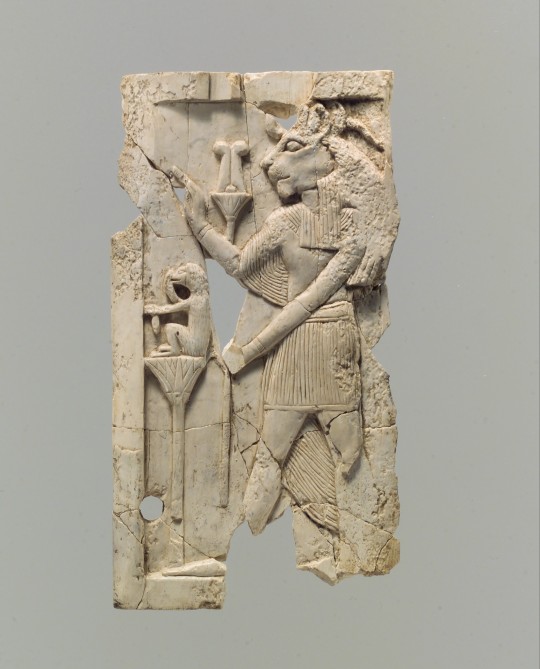
~ Furniture plaque carved in relief with lion-headed figure.
Period: Neo-Assyrian
Date: ca. 8th–7th century BC.
Place of origin: Mesopotamia, Nimrud (ancient Kalhu)
Culture: Assyrian
Medium: Ivory
#ancient#ancient art#history#museum#archeology#ancient sculpture#ancient history#archaeology#mesopotamia#Assyria#neo Assyria#assyrian#nimrud#kalhu#lion#plaque#furniture plaque#ca. 8th century B.C.#ca. 7th century B.C.
963 notes
·
View notes
Photo

Assurnasirpal II
Assurnasirpal II (r. de 884 à 859 av. J.-C.) fut le troisième roi de l'Empire néo-assyrien. Son père était Tukulti-Ninurta II (r. de 891 à 884 av. J.-C.), dont les campagnes militaires dans toute la région permirent à son fils de se doter d'un empire important et des ressources nécessaires pour équiper une armée redoutable. Assurnasirpal II est connu pour ses impitoyables conquêtes militaires et la consolidation de l'empire assyrien, mais il est probablement plus célèbre pour son grand palais de Kalhu (également connu sous le nom de Caleh et Nimroud dans l'Irak moderne), dont les reliefs muraux décrivant ses succès militaires (et ses nombreuses victimes) sont exposés dans les musées du monde entier à l'heure actuelle. Outre le palais lui-même, il est également connu pour avoir organisé l'une des fêtes les plus impressionnantes de l'histoire pour inaugurer sa nouvelle ville de Kalhu: il accueillit plus de 69 000 personnes au cours d'un festival de dix jours. Le menu de cette fête subsiste encore aujourd'hui. Il régna pendant 25 ans et son fils, Salmanazar III, lui succéda (r. de 859 à 824 av. J.-C.).
Lire la suite...
2 notes
·
View notes
Photo





Details of incised designs on the garments of a Neo-Assyrian relief sculpture From Nimrud (ancient Kalhu), Iraq Reign of Ashurnasirpal II (883-859 BCE)
Ny Carslberg Glyptotek, Copenhagen
#neo-assyrian#assyrian#nimrud#kalhu#art history#archaeology#mesopotamia#ny carlsberg glyptotek#glyptoteket#ashurnasirpal ii
6 notes
·
View notes
Text
Wow! Because this tablet was sun-dried rather than fired, it preserved DNA from almost three millennia ago, now identified with a variety of different plant families (unfortunately the results aren't specific down to the species level). The whole paper can be read here.
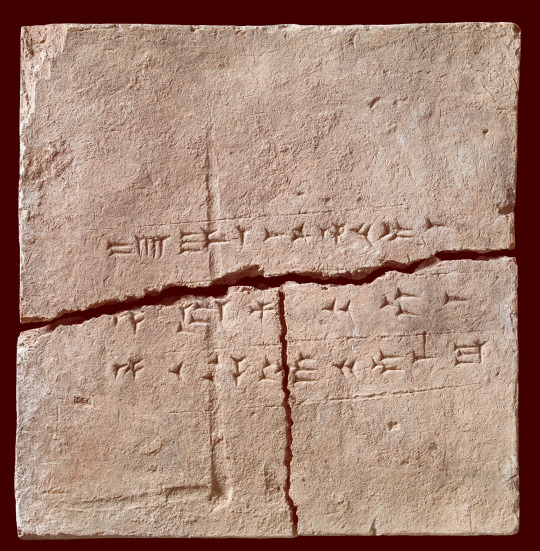
NEWS Resurrecting Ancient Flora: Unveiling Biodiversity Secrets from a 2,900-Year-Old Clay Brick
314 notes
·
View notes
Photo
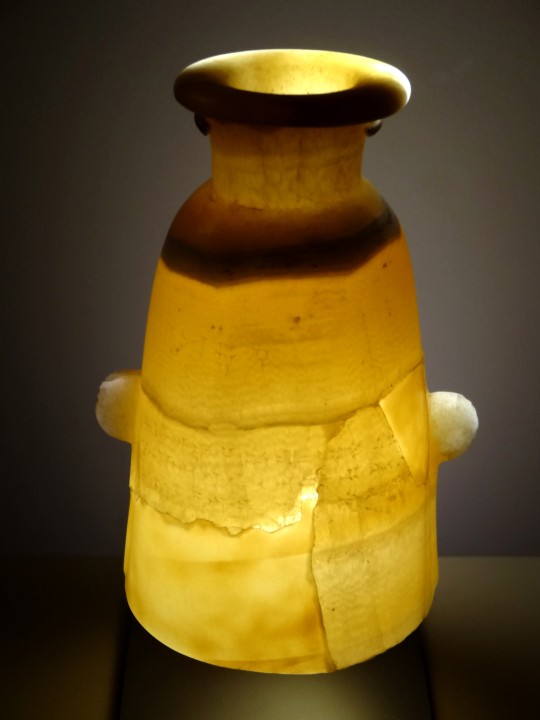
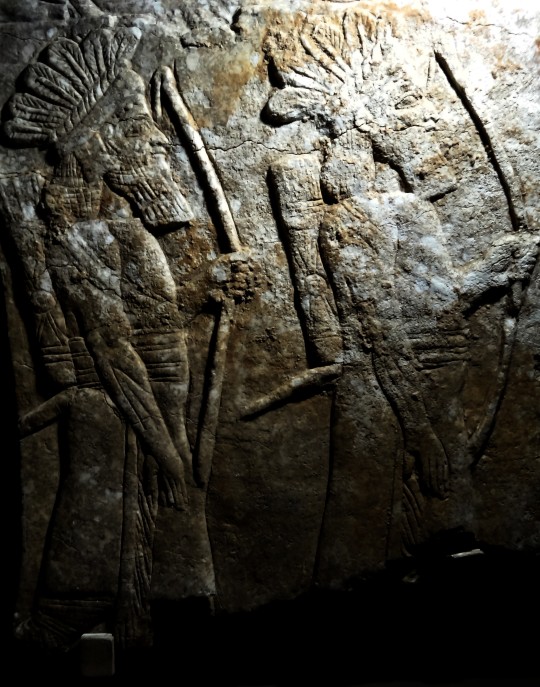


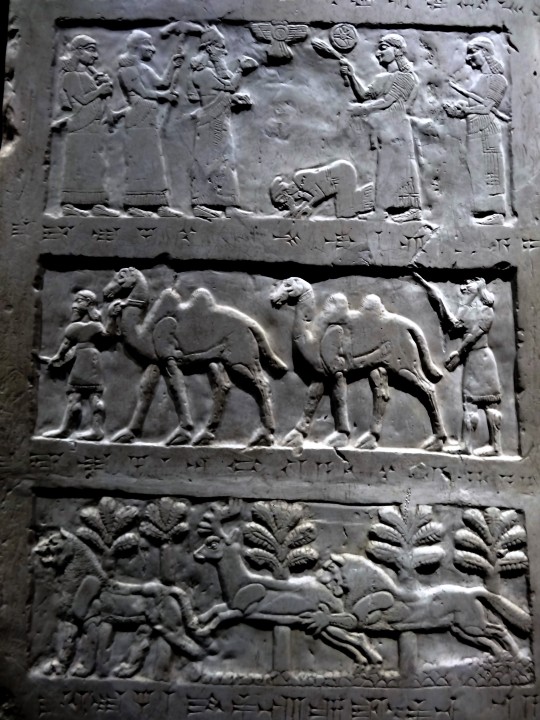


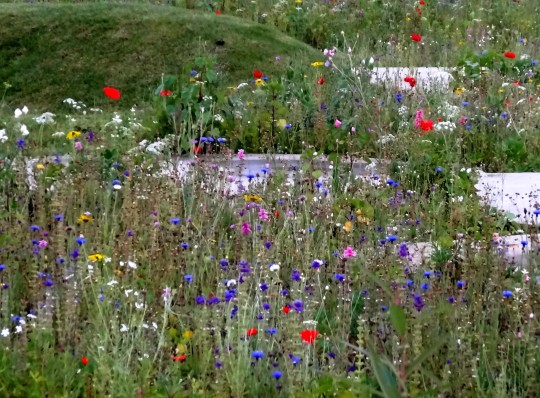
Nouveau retour à mon projet de présenter la plupart de mes 55500 photos (et des brouettes). Plus trop loin du présent….
2016. Au Louvre-Lens, il y eut une expo : “L’Histoire commence en Mésopotamie”
- alabastre en calcite - Suse, époque Néo-Babylonienne, sous Nabuchodonosor, 580av.J-C.
- les 2 suivantes: scène de guerre en albâtre - Ninive, époque Néo-Assyrienne, sous le règne d’Assurbanipal, 650 av.J-C.
- obélisque royal - Nimrud-Kalhu, époque Néo-Assyrienne, sous le règne de Salmanazar III, 840 av.J-C.
- autel du roi en albâtre - Assur, sous le règne de Tukulti-Ninurta I, 1220 av.J-C.
- les 2 dernières : les jardins
#souvenirs#louvre-lens#archéologie#l'histoire commence en mésopotamie#mésopotamie#alabastre#calcite#suse#néo-babylonien#nabuchodonosor#guerrier#albâtre#ninive#néo-assyrien#assurbanipal#obélisque#chameau#nimrud-kalhu#salmanazar#autel#assur#jardin
4 notes
·
View notes
Text
Caleb Howard of @Tyndale_House edited a new book on the famous Assyrian royal palace in Kalhu. In open access. Enjoy!
0 notes
Photo
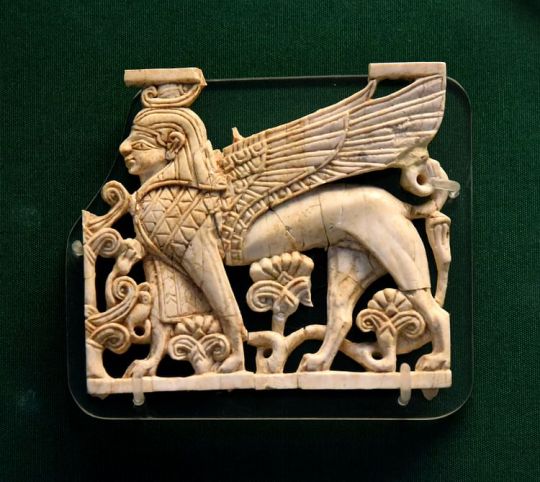
The Nimrud Ivories: Their Discovery & History
In 1845 CE, the archaeologist Austen Henry Layard began excavations at the ruins of the city of Nimrud in the region which is northern Iraq in the present day. Layard's expedition was part of a larger movement at the time to uncover ancient sites in Mesopotamia, which would corroborate stories found in the Bible, specifically in books in the Old Testament such as Genesis and Jonah. The archaeologists who excavated the sites throughout Mesopotamia in the mid-19th century CE were seeking physical evidence to support accounts of the Great Flood, the Tower of Babel, and cities such as Nineveh and Calah, among other biblical references. Their work, ironically, would have the complete opposite effect of what was intended: they discovered a civilization that existed long before the first biblical books were written, one which had, in fact, produced the first stories concerning a global flood and an ark, and which was far more advanced than had previously been thought. These discoveries would revolutionize human understanding of world history which, previously, had been heavily influenced by the Bible's version of events. Prior to these expeditions, little was known about Mesopotamian history outside of the Assyrians and Babylonians because they were the people best documented by the Greek historians and mentioned in the Bible. The great Mesopotamian cities of the past lay buried under the sands after the fall of the Assyrian Empire in 612 BCE, and their histories lay buried with them.
History of the City and Discovery of the Ivories
When Layard began his work at Nimrud, he did not even know which city he was excavating. He believed he had discovered Nineveh and, in fact, published his best-selling book on the excavation, Nineveh and its Remains, in 1849 CE, still confident in that belief. His book was so popular, and the artifacts he uncovered so intriguing, that further expeditions to the region were quickly funded. Further work in the region established that the ruins Layard had uncovered were not those of Nineveh but of another city, which was then referred to as Nimrud. The archaeologist William K. Loftus took over from Layard in 1854 CE and excavated Nimrud further discovering, among other treasures, the magnificent works of art known today as the Nimrud Ivories (also as the Loftus Ivories). Nimrud was an important city in ancient Mesopotamia known as Kalhu (also Caleh, Calah), which became the capital of the Assyrian Empire under Ashurnasirpal II (reigned 884-859 BCE), who moved the central government there from the traditional capital of Ashur.
The city existed as an important trade center from at least the 1st millennium BCE. It was located directly on a prosperous route just north of Ashur and south of Nineveh. The Assyrian Empire was ruled from Kalhu from 879-706 BCE, when Sargon II (reigned 722-705 BCE) moved the capital to his new city of Dur-Sharrukin (Khorsabad). Following the death of Sargon II, his son Sennacherib (reigned 705-681 BCE) abandoned Dur-Sharrukin and moved the capital to Nineveh. Kalhu continued to be an important city to the Assyrians, however, and the palaces and residences were richly adorned and ornamented with gold, silver, precious gems, and the intricate works of art that have come to be known as the Nimrud Ivories.
Continue reading...
100 notes
·
View notes
Text

Bastet or Sakhmet
Openwork furniture plaque with the head of a feline, Neo-Assyrian, ca. 9th/8th century BCE, Mesopotamia, Nimrud (ancient Kalhu), ivory, 5.31x4.8x2.39 cm
Metropolitan Museum of Art Inv. 62.269.10
Found in a storeroom at Fort Shalmaneser, a royal building at Nimrud that was used to store booty and tribute collected by the Assyrians while on military campaign, this piece depicts the frontal face of a feline wearing a beaded wesekh broad collar flanked by two rising sun-disc crowned uraei (mythical, fire-spitting serpents). This image is drawn from Egyptian art, where the head of a feline can represent both Bastet, the goddess of the city of Bubastis in the Nile Delta, and Sakhmet, the Egyptian goddess of war, disease, and chaos. This plaque has been attributed to the Phoenician style due to its Egyptian-influenced imagery. (MET)
72 notes
·
View notes
Text
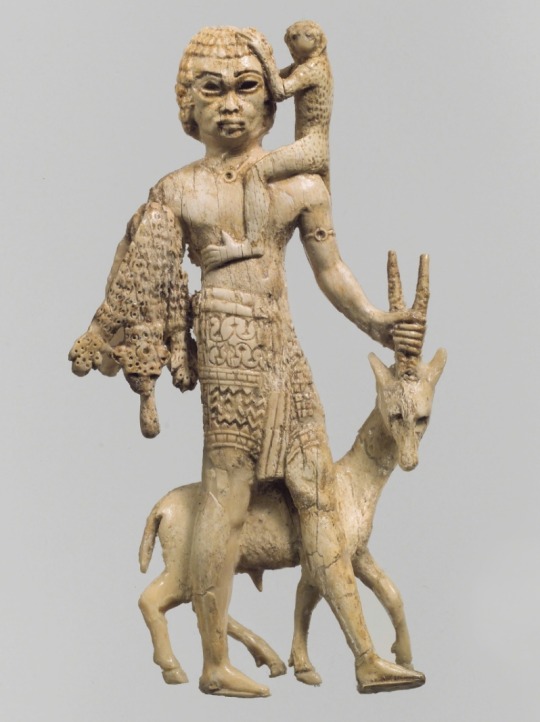
Unknown Assyrian
Statuette of a man with an oryx, a monkey, and a leopard skin, ca. 8th century B.C., Mesopotamia, Nimrud (ancient Kalhu)
Ivory
395 notes
·
View notes
Text
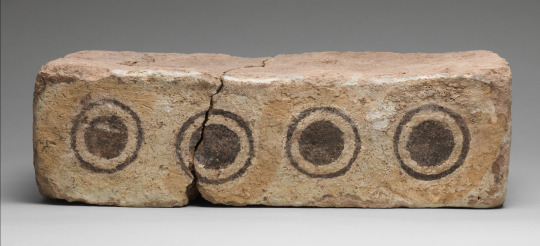
Brick with guilloche design
Neo-Assyrian, ca. 9th century BCE
Mesopotamia, Nimrud (ancient Kalhu)
Ceramic, glaze
Collection Met Museum
45 notes
·
View notes
Text
Ashurnasirpal II and the Greatest Party Ever Thrown

By Anthony Huan - https://www.flickr.com/photos/anthonyhuan/44841858665/, CC BY-SA 2.0, https://commons.wikimedia.org/w/index.php?curid=91494202
Ashurnasipal II was the third king of the Neo-Assyrian Empire, was born in 910 BCE, and reigned from 883-859 BCE. He was particularly know for his cruelty, as well as for building a new capital for Assyria at what is now known as Nimrud in 15 years. For the labor, he used enslaved captives from his campaigns to expand the boundaries of the Assyrian Empire. To maintain control over his empire, he installed Assyrian governors as opposed to allowing localities to just pay tribute which had been the standard practice before he ruled. He led campaigns along the Euphrates and into Lebanon and Phoenicia. Any revolts were harshly put down, preventing further revolts. In contrast to this violence, the artwork that Ashurnasipal left behind is rich and varied, including many reliefs and bronze bands that held up gates. He also created a zoo within his new capital as well as botanical gardens.

source: https://www.academia.edu/30872972/Merciful_messages_in_the_reliefs_of_Ashurnasirpal_II_the_land_of_Su%E1%B8%ABu
It was at the inauguration of his new palace that Ashurnasipal held a huge 10-day banquet in about 679 BCE. He inscribed on the walls of his palace about this feast. Invitations went out to the entire country, of whom 69,574 accepted. Among these were 16,000 citizens of the new capital and 5,000 dignitaries. To feed the guests required a lot of food, which included:
'1,000 oxen
1,000 domestic cattle and sheep
14,000 imported and fattened sheep
1,000 lambs
500 game birds
500 gazelles
10,000 fish
10,000 eggs
10,000 loaves of bread
10,000 measures of beer
10,000 containers of wine'
in addition to the spices and side dishes to go with these foods.

source: https://www.britishmuseum.org/collection/object/W_1849-0502-1
Exactly why Ashurnasipal decided to host such a gathering was not recorded or has not been found. What has been found is something called the Standard Inscription because it was posted many times through the palace, which traces Ashurnasipal's ancestors three generations as well as his military victories and the boundaries of his empire. It then recounts the founding of Kalhu (modern-day Nimrud). The text of the Standard Inscription begins
'Palace of Assurnasirpal, vice-regent of Aššur [national god of Assyria], chosen one of the gods Enlil and Ninurta beloved of the gods Anu and Dagan destructive weapon of the great gods, strong king, king of the universe, king of Assyria, son of Tukulti-Ninurta, great king, strong king, king of the universe, king of Assyria, son of Adad-Nirari great king, strong king, king of the universe, king of Assyria; valiant man who acts with the support of Aššur, his lord, and has no rival among the princes of the four quarters, marvelous shepherd, fearless in battle, unopposable mighty floodtide, king who subdues those insubordinate to him, he who rules all peoples, strong male who treads upon the necks of his foes, trampler of all enemies, he who smashes the forces of the rebellious, king who acts with the support of the great gods, his lords, and has conquered all lands, gained dominion over all the highlands and received their tribute, capturer of hostages, he who is victorious over all countries…'
and then describes his campaigns then the rebuilding of Kalhu. Exactly what the dignitaries thought of the party or of Kahlu hasn't been found, though the use of the title 'king of the universe' was contested by the kings of other nations.
4 notes
·
View notes
Text

CHAPTERS 48 & 49 ARE UP!
Rating: Mature Archive Warning: Graphic Depictions Of Violence Category: F/M Fandoms: The Flower from Tiamat's Fire (Visual Novel), Romance club - Fandom Relationships: Niall/Nikkal, Niall (The Flower from Tiamat’s Fire)/Nikkal (The Flower from Tiamat’s Fire) Characters: Nikkal (The Flower from Tiamat’s Fire), Niall (The Flower from Tiamat’s Fire), Su, Shimun, Ethan (The Flower from Tiamat’s Fire), Varassa (The Flower from Tiamat’s Fire), Iyar (The Flower from Tiamat’s Fire), Agga, Unzi, Kingu (The Flower from Tiamat’s Fire), Enki, Shamash, Enlil, Ishtar, Ninhursag, Other(s) Additional Tags: Alternate Universe, War, Alternate Universe - Different First Meeting, Implied/Referenced Character Death, Character Death, Original Character Death(s), Lagash’s A+ Parenting, Enki’s A+ Parenting, Shamash Is His Own Warning, Enlil Is His Own Warning, Enki Is His Own Warning, Ishtar Is Her Own Warning, Dragons, Additional world building, Eventual Smut, Slow Burn, Intrigue, Tags May Change, Hurt/Comfort, Cross-Posted on Wattpad, Battle Couple, slowburn ended in ch28, Not Beta Read from ch33 onward Language: English Words: 297 317
AU Nikkal and her friends were born earlier, and recruited into the army to fight against Kengir. Alone, Nikkal ends up under the command of Enki’s General. Her goal: to survive and regain control over her magic.
https://archiveofourown.org/works/41903664/chapters/158201767#workskin
https://archiveofourown.org/works/41903664/chapters/158202532#workskin
Okay, firstly, I will never again try to say stuff like "hopefully the next chapter will be done soon :)" and then not update for months 💀
I would like to apologise to everyone for keeping everyone waiting. The writer’s block is real as is post-bachelor-thesis burnout. Sorry again to everyone.
Happy New Year!
#my fanfiction#fanfic#fanfiction#ao3fic#ao3 link#ao3 fanfic#ao3#wattpad link#wattpad fanfiction#wattpad#and we will not fear#kvietok z ohňa tiamat#niall x nikkal#nikkal x niall#nikkalxniall#niallxnikkal#the flower from tiamat's fire
3 notes
·
View notes
Photo

Reliefs Muraux: Scènes des Guerres d'Assurnasirpal II au British Museum
Le puissant roi
J'ai passé au fil de l'épée 600 de leurs guerriers et je les ai décapités; j'en ai pris 400 vivants; j'ai emmené 3 000 captifs; j'ai pris possession de la ville pour moi; j'ai envoyé les soldats vivants et les têtes à la ville d'Amidi, la ville royale.
Lire la suite...
0 notes
Text

Cropped image of a monumental stone relief from the temple of Ninurta at Kalhu dating to circa 883-859 BC, showing the god Ninurta, or possibly Adad, pursuing a leonine monster.
Source: Wikipedia
3 notes
·
View notes
Text
Black Obelisk of Shalmaneser III
The Black Obelisk of Shalmaneser III is a black limestone Assyrian sculpture with many scenes in bas-relief and inscriptions which comes from Nimrud, or ancient Kalhu in northern Iraq, and commemorates the deeds of King Shalmaneser III who reigned from 858 to 824 BCE.

The obelisk is historically significant because it is thought to display the earliest ancient depiction of the biblical figure Jehu, King of Israel who appears in the Book of Kings. Some scholars have questioned the traditional identification of "Yaw" as Jehu and instead identify the ruler as another king, Jehoram of Israel. It is also significant for having the first known reference to the Persians.

In the carvings, tribute offerings are shown being brought from identifiable regions and peoples. It was erected as a public monument in 825 BC at a time of civil war, in the central square of Nimrud.




6 notes
·
View notes
Photo
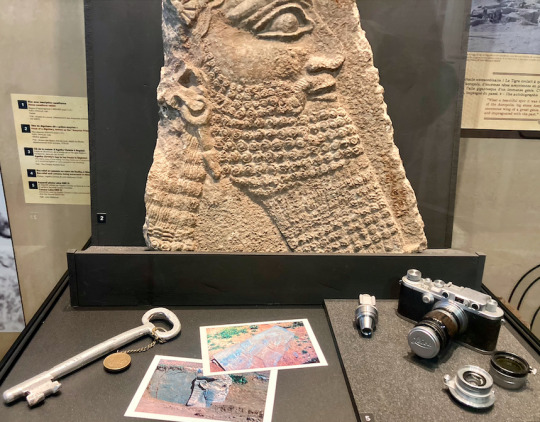
Copie en aluminium faite par Agatha Christie car plus légère à porter dans son sac à main de la "Clé de sa Maison à Bagdad" et "Appareil Photo Leica DRP III et Objectifs" utilisés par Agatha Chritie en Syrie et en Irak (avant et après la Seconde Guerre Mondiale) devant une "Tête de Dignitaire" dit "Prêtre Assyrien" (détail) en albâtre gypseux de Kalhu en Irak (934-610 avant J.-C.) à l'exposition "Agatha Christie en Quête d'Archéologie" au Musée “Vesunna” de Périgueux, Dordogne, avril 2023.
2 notes
·
View notes